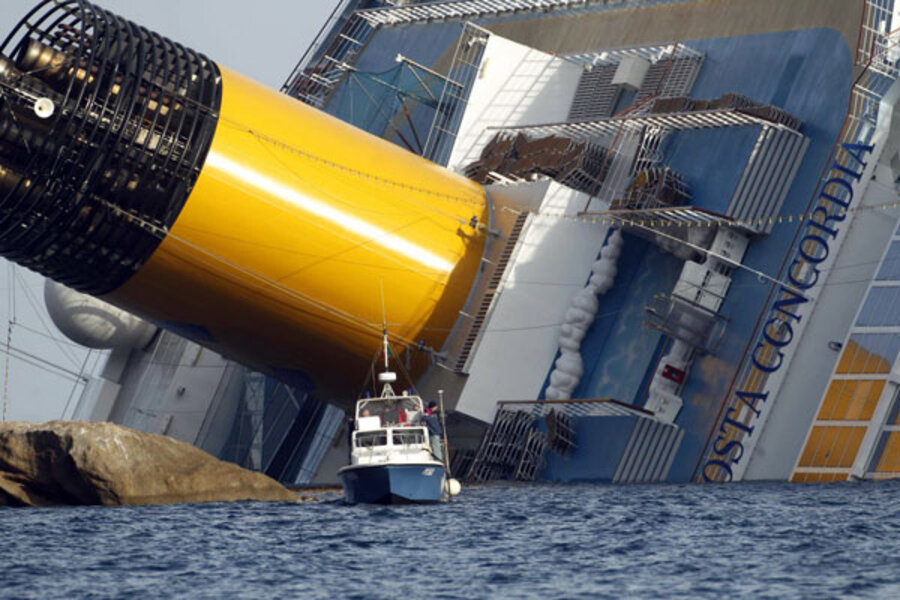Costa Concordia: Stowaways the latest uncertainty
Loading...
| GIGLIO, Italy
Unregistered passengers might have been aboard the stricken cruise liner that capsized off this Tuscan island, a top rescue official said Sunday, raising the possibility that the number of missing might be higher than the 20 previously announced.
Rescuers, meanwhile, resumed searching the above-water section of the Costa Concordia but choppy seas kept divers from exploring the submerged part, where officials have said there could be bodies.
"There could have been X persons who we don't know about who were inside, who were clandestine" passengers aboard the ship, Franco Gabrielli, the national civil protection official in charge of the rescue effort, told reporters at a briefing on the island of Giglio, where the ship, with 4,200 people aboard rammed a reef and sliced open its hull on Jan. 13 before turning over on its side.
Gabrielli said that relatives of a Hungarian woman have told Italian authorities that she had telephoned them from aboard the ship and that they haven't heard from her since the accident. He said it was possible that a woman's body pulled from the wreckage by divers on Saturday might be that of the unregistered passenger.
But the identity of that body and of three male bodies, all badly decomposed after days in the water, have yet to be established. Gabrielli said they have identified the other eight bodies: four French, an Italian, a Hungarian, a German and a Spanish national.
Until Sunday, authorities had said that 20 people are still missing.
The search had been halted for several hours early Sunday, after instrument readings indicated that the Concordia has shifted a bit on its precarious perch on a seabed just outside Giglio's port. A few yards away, the sea bottom drops off suddenly, by some 65 to 100 feet, and if the Concordia should abruptly roll off its ledge, rescuers could be trapped inside.
When instrument data indicated the vessel had stabilized again, rescuers went back in, but only explored the above-water section. Choppy seas kept divers from exploring the submerged part of the ship, including the restaurant and evacuation staging areas where survivors have indicated that people who did not make it into lifeboats during the chaotic evacuation could have remained.
Passengers were dining at a gala supper when the Concordia sailed close to Giglio and struck the reef, which is indicated on maritime and even tourist maps.
There are also fears that the Concordia's double-bottom fuel tanks could rupture in case of sudden shifting, spilling nearly 500,000 million gallons of heavy fuel into the pristine sea around Giglio, which is part of a seven-island archipelago in some of the Mediterranean's most pristine waters and a prized fishing area.
But Gabrielli said pollutants found near the ship have been detergents and other substances, including chlorine, apparently from the wreck of the ship, which carried some 3,200 passengers and a crew of 1,000. Any fuel traces found were "compatible with what you find in a port," he said.
Ferries and cargo ships regularly call at Giglio's port.
Sophisticated oil-removal equipment has been standing by, waiting for the search-and-rescue operations to conclude before workers can start extracting the fuel in the tanks.
The Italian captain, Francesco Schettino, is under house arrest as prosecutors investigate him for suspected manslaughter, causing a shipwreck and abandoning the ship while many were still aboard.
Operator Costa Crociere, a subsidiary of US-based Carnival Cruise Lines, has said that Capt. Schettino had deviated without permission from the vessel's route in an apparent maneuver to sail close to the island and impress passengers.
Schettino, despite audiotapes of his defying Coast Guard orders to scramble back aboard, has denied he abandoned ship while hundreds of passengers were desperately trying to get off the capsizing vessel. He has said he coordinated the rescue from aboard a lifeboat and then from the shore.







